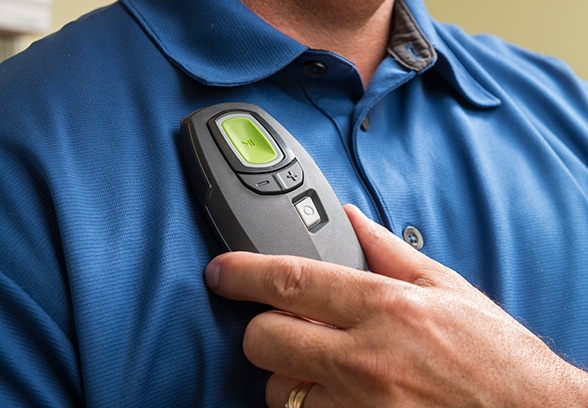Feb. 10, 2018
A major determining factor of upper airway patency during sleep is the activity of the genioglossus muscle. Activation of this muscle via stimulation of the hypoglossal nerve is a creative new approach for treatment of obstructive sleep apnea (OSA). Hypoglossal nerve stimulation therapy is commonly referred to as Inspire, a reference to the name of the company — Inspire Medical Systems — that developed the treatment, which was approved by the Food and Drug Administration in 2014.
 Inspire upper airway stimulation system
Inspire upper airway stimulation system
The Inspire upper airway stimulation system includes a generator, sensing lead and stimulation lead. Image reprinted with permission from Inspire Medical Systems.
The Inspire upper airway stimulation system consists of a small impulse generator implanted beneath the clavicle, a tunneled breathing sensing lead placed between the external and intercostal muscles, and a tunneled stimulation lead attached to the branch of the hypoglossal nerve that produces tongue protrusion.
When the sensing lead detects inspiration is occurring, the impulse generator sends a signal via the stimulation lead to the hypoglossal nerve, which results in slight forward displacement of the stiffened tongue. The impulse generator is similar in size and appearance to a cardiac pacemaker, and the latest version is magnetic resonance imaging compatible.
The pivotal study of hypoglossal nerve stimulation was the Stimulation Therapy for Apnea Reduction (STAR) trial, which was published by Patrick J. Strollo Jr., M.D., and others in The New England Journal of Medicine in 2014. The trial included 126 patients with OSA who had difficulty initiating or maintaining continuous positive airway pressure (CPAP) therapy.
The stimulator was associated with a 68 percent reduction in the apnea-hypopnea index (AHI), from 29.3 events an hour to 9.0 events an hour at 12 months. Sixty-six percent of subjects achieved a reduction of at least 50 percent and an AHI of less than 20 events an hour. The AHI reduction was accompanied by improvements in daytime sleepiness and functional outcomes of sleep. The rate of serious adverse events was less than 2 percent.
Nonserious side effects included temporary pain at incision sites, transient tongue weakness and tongue soreness. Tongue soreness improved over time with acclimatization, device reprogramming or both. Maintenance of upper airway stimulation therapy efficacy at three and five years in the STAR cohort has subsequently been reported.
Treatment at Mayo Clinic
The hypoglossal nerve stimulation therapy program at Mayo Clinic's campus in Minnesota is a joint effort of the Center for Sleep Medicine and Otorhinolaryngology — Head and Neck Surgery. The evaluation of potential candidates begins in the Center for Sleep Medicine. The eligibility requirements for Inspire stimulation therapy match those of the STAR trial:
- Age 22 years or older
- Moderate to severe OSA (AHI 15 to 65 events/hour)
- Body mass index (BMI) below 33 kg/m2
- Difficulty accepting or adhering to CPAP
- No significant comorbidities (neuromuscular disease, hypoglossal nerve palsy, severe cardiopulmonary disease, active psychiatric disease)
- No pronounced upper airway anatomic abnormalities (for example, grade 3 to 4 tonsils)
- Anterior-posterior predominant retropalatal collapse on drug-induced sleep endoscopy
This therapy is currently not considered appropriate for patients with mild OSA, children, patients with a body mass index of 33 kg/m2 or more, or patients who are successfully using CPAP but may be curious about an alternative approach.
Screening requires drug-induced sleep endoscopy (DISE) performed by specialists on staff. Patients are excluded if DISE reveals complete concentric collapse at the retropalatal airway, as protrusion of the tongue will not resolve this pattern of airway obstruction.
Establishing coverage for the procedure from insurers may result in a delay between the initial determination of eligibility and surgery. Currently, commercial insurers typically deny initial requests for Inspire coverage, but the appeal process is generally successful. For government insurance, coverage decisions have been mixed.
Follow-up care
 Remote controls impulse generator
Remote controls impulse generator
A hand-held remote controls the impulse generator. Image reprinted with permission from Inspire Medical Systems.
Approximately one month after device implantation, patients return for device education and activation. The impulse generator is controlled via a hand-held remote. Patients are advised to use the device nightly and slowly self-titrate the stimulation level over a limited range for one month. Polysomnography to formally titrate stimulation parameters occurs approximately two months after implantation. Hours-of-use information can be collected during device interrogation at follow-up visits.
For more information
Strollo PJ Jr, et al. Upper-airway stimulation for obstructive sleep apnea. The New England Journal of Medicine. 2014;370:139.